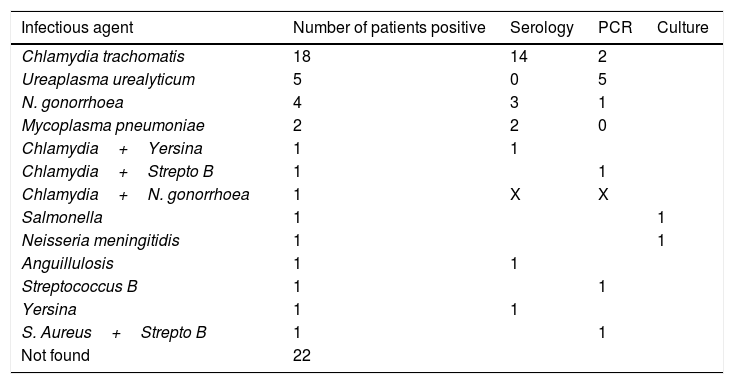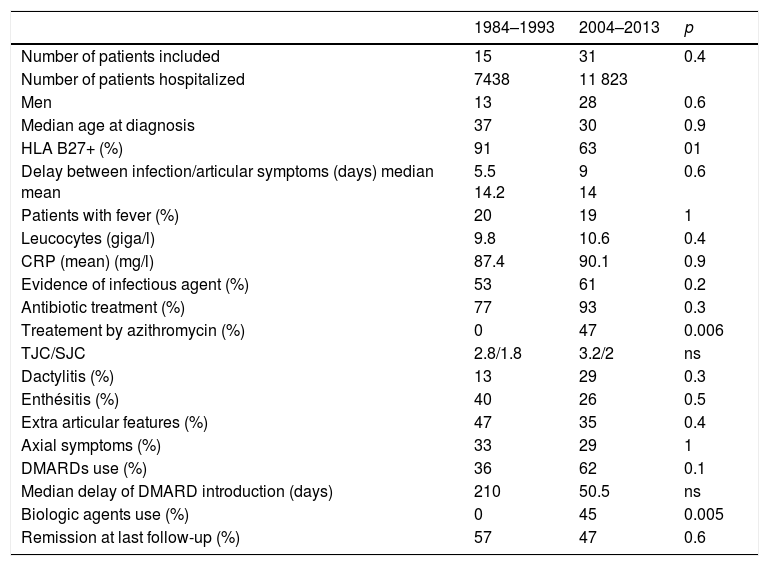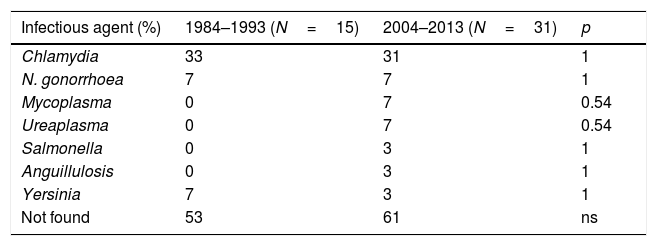Reactive arthritis (ReA) is sterile arthritis occurring after extra articular bacterial infection. The aim of this study was to analyze, over 30 years, clinical, biological and imaging characteristics as well as therapeutic management of new cases of ReA, comparing two periods.
Methodsretrospective monocentric study, data of all the patients followed in our unit between January 1st 1984 and April 2014 with the diagnosis or ReA were analyzed (clinical and biological features, management and outcome), and compared between two periods: from January 1984 to December 1993, and from January 2004 to December 2013.
ResultsSixty two patients fulfilling international diagnosis criteria were analyzed. There was no significant difference between the two periods in number of new cases, clinical presentation, biological data or outcome. Changes in therapeutic management were obvious with occurrence of anti TNF in the recent period.
ConclusionReactive arthritis is still a current rheumatologic problem in a developed country, with a need of early and tailored rheumatologic management.
Las artritis reactivas (ARe) son artritis estériles que se manifiestan después de una infección bacteriana extraarticular. El objetivo de este estudio es analizar, durante 30 años, las características clínicas, biológicas e imagenológicas, así como la gestión del tratamiento de la ARe, mediante la comparación de 2 periodos.
MétodosEstudio retrospectivo monocéntrico. Se analizaron los datos de todos los pacientes diagnosticados con ARe en nuestra unidad entre el 1 de enero de 1984 y abril de 2014 (rasgos clínicos y biológicos, gestión y resultados) y se compararon con 2 periodos: de enero de 1984 a diciembre de 1993, y de enero de 2004 a diciembre de 2013.
ResultadosSe analizaron los datos de 62 pacientes que cumplieron los criterios de diagnóstico internacionales. No existió una diferencia significativa entre los 2 periodos en la cantidad de casos, presentación clínica, datos biológicos o resultados. Los cambios de la gestión del tratamiento fueron evidentes, con la aparición de anti-TNF en el periodo reciente.
ConclusiónLa artritis reactiva continúa siendo un problema reumatológico actual en los países desarrollados, con una necesidad de tratamiento reumatológico temprano y personalizado.
Reactive arthritis (ReA) is defined as arthritis developing 2–4 weeks after extra articular infection, without evidence of microorganism in the joint using classical culture tools.1,2 The triggering infection is mainly located in gut or genito urinary mucosa. The classical clinical presentation is an acute oligo arthritis, mainly located at the lower limbs, with possibility of axial (sacro iliac and spine) involvement and enthesitis, as well as extra articular features (ophthalmologic or dermatologic symptoms). ReA is considered part of spondyloarthritis spectrum, sharing with this entity common clinical and imaging features, as well as frequent association with HLA-B27 haplotype.3,4 Outcome is variable, with possibility of resolution after several months, or relapses or chronic evolution, leading sometimes, after years, to ankylosing spondylitis.
The aim of this study was to analyze, over 30 years, in new cases of ReA the clinical, biological and imaging characteristics, as well as management modalities, comparing two periods.
Patients and methodsThis is a descriptive, monocentric retrospective study of patients hospitalized in the Rheumatology department of the Centre Hospitalier Régional et Universitaire in Besançon, France, between January 1st 1984 and april 2014 with ReA as principal diagnosis, according to ICD codes M02 and M03. The charts were reviewed by experienced rheumatologists (AB, CP, DW) and patients were included if they fulfilled international classification criteria.2 The following data were recorded: demographic characteristics, HLA-B27 status, initial infection (location and bacteriological species) and its diagnosis method, as well as the potential antimicrobial treatment. Clinical features of ReA were noted: delay between infection and rheumatologic symptoms onset, general symptoms (fever), tender and swollen joint counts, presence of enthesitis or dactylitis, axial symptoms, and extra articular symptoms (conjunctivitis, uveitis, balanitis). The rheumatic treatments and their introduction delay were collected, as well as the outcome. For this purpose, we studied and compared charts of patients with ReA over two periods, from January 1984 to December 1993, and from January 2004 to December 2013.
Results were expressed as numbers for the microbiological findings, and means or percentage for clinic-biological data. χ2 test were used for comparisons of percentages, with Yates and Fisher corrections if needed, and Mann–Whitney if t test were not applicable. Significance threshold was p less than 0.05.
ResultsOne hundred and twenty charts were analyzed, and 62 were finally included, the causes of exclusion were wrong diagnosis and absence of classification criteria fulfilment. They were 52 men (83.9%) and 10 women (16.1%) with a mean age of 34 years (12–69). Six patients (10%) had a familial history of inflammatory rheumatic disease, four of them had a familial background of spondyloarthritis. At admission, 20% of the patients were febrile, and 82% had elevated biologic markers of inflammation (mean CRP 94mg/l, leukocytes (WBC) 10.2G/l). A complete urethro-oculo-synovial syndrome was noted in 19.4%. The mean number of painful joints was 3, and of swollen joints 2.1; two patients had no synovitis, but in one case we noticed axial symptoms with buttock pain and a dactylitis. The most frequently involved joints were the knee, then ankle, wrist and tarsal joints; dactylitis was present in 19.4% of the cases. Inflammatory back pain was mentioned in 22.3% of the cases, and enthesopathy in 24.2%, mainly talalgia. Among extra rheumatic involvement, conjunctivitis was the most frequent (27.4%); three cases of palmar and/or plantar pustulosis and three cases of balanitis were observed. HLA-B27 typing was positive in 36 out of 56 assessments (64.3%).
Urethritis was described in 43.6% and dysenteric syndrome in 21% of the cases. Eight cases exhibited no infectious symptoms, and in 7 of them, evidence of an infection was brought by systematic research. Rheumatologic symptoms appeared with a mean of 14.7 days after the supposed infection. Evidence of infection was found in 63.3%, with serological proof in 37%, PCR on urethral sampling in 14% and vaginal in 2%, blood and stool cultures in 2% of the 62 cases each. Chlamydiae trachomatis was the most frequent infectious agent (37% of the cases with evidence of infection), found in 83.3% by serology, 11% by PCR (uretral or vaginal), and 5.6% by both methods; in three cases it was associated with another infection (streptococcus, Yersinia, gonococcus). The following most frequent species were Ureaplasma urealyticum and Neisseriae gonorrhoeae (Table 1). In 35 cases, an antibiotic treatment for the inaugural infection was mentioned.
Distribution of infectious agents.
| Infectious agent | Number of patients positive | Serology | PCR | Culture |
|---|---|---|---|---|
| Chlamydia trachomatis | 18 | 14 | 2 | |
| Ureaplasma urealyticum | 5 | 0 | 5 | |
| N. gonorrhoea | 4 | 3 | 1 | |
| Mycoplasma pneumoniae | 2 | 2 | 0 | |
| Chlamydia+Yersina | 1 | 1 | ||
| Chlamydia+Strepto B | 1 | 1 | ||
| Chlamydia+N. gonorrhoea | 1 | X | X | |
| Salmonella | 1 | 1 | ||
| Neisseria meningitidis | 1 | 1 | ||
| Anguillulosis | 1 | 1 | ||
| Streptococcus B | 1 | 1 | ||
| Yersina | 1 | 1 | ||
| S. Aureus+Strepto B | 1 | 1 | ||
| Not found | 22 |
PCR: polymerase chain reaction.
Non steroidal anti inflammatory drugs (NSAIDs) were used in 91.8% of cases. The absence of use was due to contra indications or intolerance. Disease modifying anti rheumatic drugs (DMARDs) were introduced in 51.8% of patients with a median delay of 60 days from the first rheumatic symptoms, with salazosulfapyridin as the first choice. Use of TNF blockers was recorded in 15 patients (24.2%), mean age 35 years, with a median delay of 116 days.
The outcome was variable, and longstanding follow-up was available in 42 patients: with a mean follow-up duration of 34 months, 52% are in remission, under or without treatment, 44% developed spondyloarthritis, and 4% psoriatic arthritis,.
The comparison of the two cohorts did not reveal any significant change in the frequency of ReA in hospitalized patients or in the profile of these patients (Tables 2 and 3) (age, sex, type of infection, rheumatologic presentation or outcome). In the most recent period, the use of Azithromycin for treatment of Chlamydia, and of anti TNF agents were more frequent.
“Global” comparison of the 2 cohorts.
| 1984–1993 | 2004–2013 | p | |
|---|---|---|---|
| Number of patients included | 15 | 31 | 0.4 |
| Number of patients hospitalized | 7438 | 11 823 | |
| Men | 13 | 28 | 0.6 |
| Median age at diagnosis | 37 | 30 | 0.9 |
| HLA B27+ (%) | 91 | 63 | 01 |
| Delay between infection/articular symptoms (days) median mean | 5.5 14.2 | 9 14 | 0.6 |
| Patients with fever (%) | 20 | 19 | 1 |
| Leucocytes (giga/l) | 9.8 | 10.6 | 0.4 |
| CRP (mean) (mg/l) | 87.4 | 90.1 | 0.9 |
| Evidence of infectious agent (%) | 53 | 61 | 0.2 |
| Antibiotic treatment (%) | 77 | 93 | 0.3 |
| Treatement by azithromycin (%) | 0 | 47 | 0.006 |
| TJC/SJC | 2.8/1.8 | 3.2/2 | ns |
| Dactylitis (%) | 13 | 29 | 0.3 |
| Enthésitis (%) | 40 | 26 | 0.5 |
| Extra articular features (%) | 47 | 35 | 0.4 |
| Axial symptoms (%) | 33 | 29 | 1 |
| DMARDs use (%) | 36 | 62 | 0.1 |
| Median delay of DMARD introduction (days) | 210 | 50.5 | ns |
| Biologic agents use (%) | 0 | 45 | 0.005 |
| Remission at last follow-up (%) | 57 | 47 | 0.6 |
(ns=non significant) TJC: tender joint count; SJC: swollen joint count, DMARDs: disease modifying anti rheumatic drugs.
Distribution of infective agents found in cases of reactive arthritis between the two periods.
| Infectious agent (%) | 1984–1993 (N=15) | 2004–2013 (N=31) | p |
|---|---|---|---|
| Chlamydia | 33 | 31 | 1 |
| N. gonorrhoea | 7 | 7 | 1 |
| Mycoplasma | 0 | 7 | 0.54 |
| Ureaplasma | 0 | 7 | 0.54 |
| Salmonella | 0 | 3 | 1 |
| Anguillulosis | 0 | 3 | 1 |
| Yersinia | 7 | 3 | 1 |
| Not found | 53 | 61 | ns |
Reactive arthritis may have two backgrounds: epidemic, with classical description during world war 1st,5 and sporadic. It corresponds to arthritis related to a preceding infection outside the joint, mainly in the gut6 or the genito urinary tract, with some classical species,7 and other less frequent (e.g. Clostridium8 or N. gonorrhoea).7 The estimated annual incidence varies among studies and countries between 0.6 and 30/1,000,000 (4). Due to improvement in collective hygienic conditions, one may expect a reduction in incidence of ReA in developed countries. It has been recently shown a decline in ReA diagnoses despite an increase in chlamydia diagnoses over the 1992–2012 period in Sidney, Australia.9 Our results do not share this conclusion, in fact, the incidence of new cases of ReA in our department seems similar between the two periods of analysis (Table 2), Chlamydia being the most frequent incriminated (Table 1).
The microbiological profile of potential triggers is tributary of the detection method. Direct evidence of infection is difficult to obtain, since the micro organism is no more present at the site of infection when arthritis occurs,7 and indirect assessments, mainly serologic tests, have limitations.10 The profile of microbiological species is not different between the recent period and 30 years ago in our series, with a similar proportion of bacteriological evidence missing despite use of new techniques in the recent period (e.g. polymerase chain reaction).
The clinical presentation of rheumatologic features and extra articular manifestations did not differ significantly between the two periods.
Some changes were obvious in the therapeutic management. The type of antibiotics used for the treatment of the initial infection changed over the years, due to availability of new treatments, whereas, efficacy of antibiotics upon rheumatologic symptoms is still not demonstrated.11 The use of conventional synthetic DMARDs is similar over the two periods, but the use of anti TNF agents appear in the recent period; efficacy and safety of TNF blockers were observed in case reports12 and observational series13 in the recent years.
The outcome is more difficult to analyze, since one third of the patients were lost of follow-up after six months in the whole population. For patients with follow-up, half of them was considered in remission, with or without treatment, and the remaining developed chronic spondyloarthritis, illustrating the several phenotypes of the disease.14 Again, no significant changes were obvious in outcome between the two periods of observation. A recent paper analyzed the outcome of 21 cases of epidemic outbreak of ReA after waterbone gastro enteritis15: after one year, one third of the patients demonstrated a chronic evolution, defined as a duration of arthritis over 6 months.4
Our study has some limitations. The retrospective analysis, and some missing data, particularly in follow up, dim the conclusions. The absence of universal classification criteria, associated with the difficulty of diagnosis in cases without the evidence of infection represent another limitation. Referral biases arise for this kind of study, and the analysis performed only on inpatients in one department of the hospital. Due to the acute presentation, patients were referred via the general practitioner or the emergency room, without major change over the two periods (data not shown). Nevertheless, the large period of monocentric observation and the number of patients provide some interest for this analysis.
Our study confirms that ReA is still present in a tertiary rheumatology unit in a developed country, without major changes over 30 years in clinical presentation and microbiologic context. ReA keeps a potential evolution towards chronicity that justifies an early rheumatologic management and follow-up with tailored treatment.
Ethical disclosuresProtection of human and animal subjectsThe authors declare that no experiments were performed on humans or animals for this study.
Confidentiality of dataThe authors declare that no patient data appear in this article.
Right to privacy and informed consentThe authors declare that no patient data appear in this article.
Conflicts of interestThe authors declare no conflict of interest concerning this manuscript.








